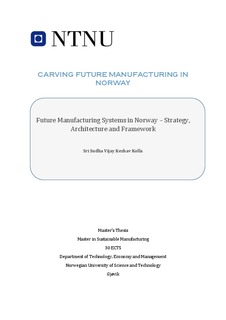| dc.description.abstract | This study investigates the suitability of Cyber Physical Systems (CPS) in Norwegian manufacturing industries and its implementation. This study explores the research and innovation needs in Norway which will be given as inputs to Strategic Research Agenda (SRA) 2030 of European Commission to share future manufacturing strategies in Norway. The objectives of the research are to identifying the opportunities and challenges of CPS, developing a feasible reference architecture of CPS which benefits Norwegian manufacturing industry, a framework to identify driving forces of CPS and necessary actions, and strategy development for future manufacturing systems in Norway to fulfil the needs of sustainability and societal challenges. Previous research offers a descriptive knowledge on future manufacturing systems and digital transformation to Industry 4.0 with associated challenges and opportunities. This study advances in to real time challenges and step by step implementation procedure for CPS in Norway. As a part of the research 3 in depth interviews with manufacturing and R&D organizations in Norway are carried with qualitative, observational research strategy. The key findings of the research are, companies in Norway interested in digital transformation to CPS but lack of skilled employees, analysis of big data, high investment cost, uncertainty on payback, and security of CPS are major barriers to it. Therefore, a suitable strategy for implementation of CPS, reference architecture for CPS, and framework for CPS are developed to support the key challenges. New concepts such as collaborative manufacturing, knowledge quadrangle, and security management of CPS are used to support the models developed. Impact of CPS on industrial services, recommendations to implement CPS and future research are discussed. Finally, inputs to SRA 2030 with objects, research, and innovation needs are presented and discussed. | nb_NO |
